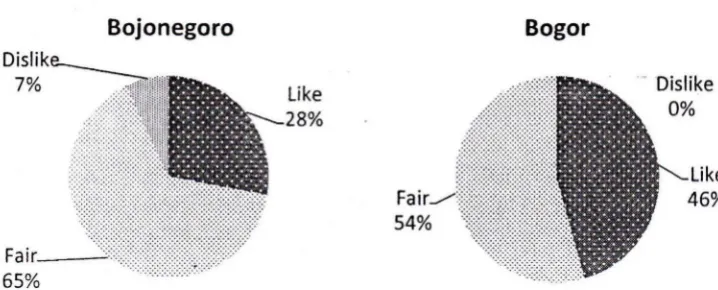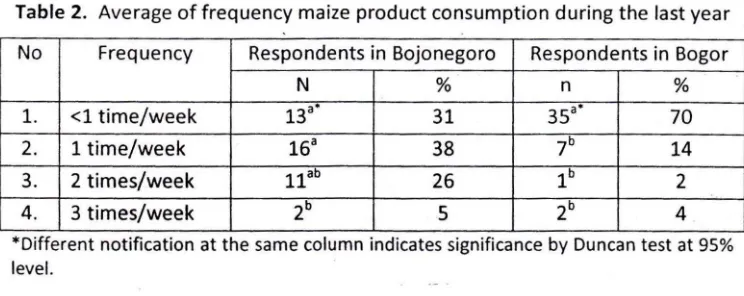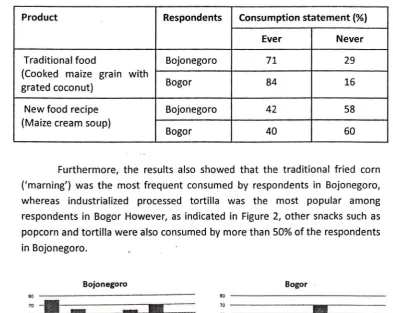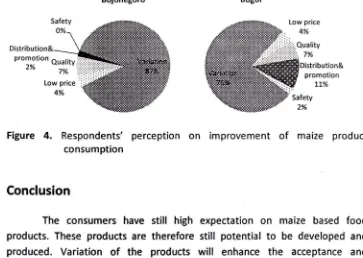I 0\
"
0\I 00
"
0\..
z 00 VI H
FOOD Q!JALITY,
SAFETY
&
NUTRITION
IERFR/T
-
CENTER-Editor:
Lilis Nuraida
Purwiyatno Hariyadi
Ratih Dewanti-Hariyadi
Harsi D. Kusumaningrum
Desty Gita Pratiwi
Nelis Immaningsih
INVESTING IN FOOD QUALITY,
"
SAFETY AND NUTRITION
International Conference Proceeding Investing in Food Quality, Safety
&
Nutrition:Lessons Learned from Current Food Crisis Jakarta, October 27-28, 2008
Organized by:
Southeast Asian Food & Agricultural Science & Technology (SEAFAST) Center Bogor Agricultural University ,
Norman Borlaug Institute-for International Agriculture Texas A&MUniversity
Supported by:
United States Department of Agriculture (USDA)
Ministry of Agriculture,Republic of Indonesia
Indonesian Association of Food Technologists (PATPI)
Editor: Lilis Nuraida Purwiyatno Hariyadi Ratih Dewanti-Hariyadi Harsi D. Kusumaningrum
Desty Gita Pratiwi Nelis Immaningsih
Southeast Asian Food & Agricultural Science & Technology (SEAFAST) Center, Bogor Agricultural University
CONTENT
Preface ...... iii
Keynote Speech of The Minister of Agriculture, Republic of Indonesia ... xi
Welcome Speech of Rector of Bogor Agricultural University ... ... xvii
Welcome Remarks of SEAFAST Center ... ... xxi
Organizers ... xxiii
Lessons Learned from the Current Food Crisis
Food Science and Technology: Challenges and Opportunities as a Response to the Current Food Crisis ... 1Ken Buckle Avoiding the Double Burden of Over and Under Nutrition in the Current Food Crisis ... : ... 17
Rosemary Walzem
Assuring Nutritionally Adequate & Safe Food Supply
Current Situation of Food Security in Indonesia ... ... 33Achmad Suryana Nutrition Security: What Next After the National Food and Nutrition Workshop? ... 43
Soekirman Partnership for Technology Transfer to MSMEs: Improving Food Quality and Safety ...... ... 55
Purwiyatno Hariyadi
Roles of Food Industries
R&D Strategy to Overcome Food Crisis ... 67Don Sullins Kraft's Supply Chain Approach to Food Safety ... ... 69
James Andrade Food Quality, Nutrition and Safety in Food Service Industry: Challenges and Opportunities ...... ... 77
Mahmood A. Khan
- - -
---Investing In Food Quality, Safety and Nutrition
Roles of Consumers
Consumer Behavior towards Choices & Its Consequences on Nutritional Status ... ... ... ... ... ... .. ... ... ... ... 87
John Palmer
Improving Food Safety
&:
QualityFood Safety Policy in Indonesia ... . 95
Dedi Fardiaz
Improving of Food Safety and Quality of SMEs in Indonesia: lesson
learned ... ... ... ... ... 103
Steven Gregary
Assuring Indonesian Seafood Quality and Safety: Lessons from the
past for a better future .. .. ... ... ...
105
Achma:d Poernomo
Use of Simple Micro-titer Plate Assay for Assessment of
Biofilm-Forming Bacteria in High Risk Area of Frozen Seafood Plant ... ... 115
Damkerng Bundidamorn and Sudsai Trevanich
Isolation and Identification of Coliforms and Escherichia cali in Frozen Ready to Eat Food under Long Term Storage ... .. セ@
121
Pornrujee Suppadit and Sudsai Trevanich
Growth Inhibition of Contaminated Microbial Spores in Pasteurized
Milk by Tea Polyphenol Extract ... : ...
127
Ornurach Uasiriphan and Arunsri Leejeerajumnean
Migration and Contamination of Polyglycerol Acetate as Alternative Plasticizers in Polyolefin Thermoplastic Matrices in Contact with Water and Olein-Oil Media ... ... ... · ...
139
Basuki Wirjosentono, Hankelman Sarumaha and Marpongahtun
The Role of Cisadane - Serpong Water Treatment Plant to Ensure
24-Hour- Drinking Water Supply ... .. ....
149
Audrey Caron Rumamby
Using Organic Acids, Sodium Hypochlorite And Ozone For Listeria
monocytogenes Reduction In Fresh-Cut Carrots .. .. ...
161
Phunnathorn Phuchivatanapong and Arunsri Leejeerajumnean
Influence of Combination of Alginate, Carrageenan, and Guar Gumas Stabilizing Agents on Ice-Cream Quality ... ... .. ...
167
Analysis and Planning of Garbage Treatment in a Drinking Water
Treatment Plant ... 179
Lidia Khosmatika
A Study of Cisadane River Based on the Trace Result of PT. Tirta
Cisadane) ... .. ... ... 193
Hartini Adjam
Role of Students in Sustaining Food Safety in Campus: A Case Study in " Food Sellers Mentoring" Program in Bogor, Indonesia ... 203
Galih Nugroho and Kamalita Pertiwi
Inhibition of Aspergillus parasiticus Growth and Reduction of Aflatoxin by Yeast Isolated from Ragi, an Indonesian Traditional Culture Starter ... 211
R. Dewanti-Hariyadi, D. S. Raharjanti,
c.c.
Nurwitri and E.Kusumaningtyas
Improving Competitiveness of Traditional Foods
Policy on Development of Traditional Foods ... ... ... 227
Arman Moenek
Empowerment of Farmers and SMES of Traditional Foods: Lesson
Learned ... ... ... ... ... ... .. 233
Mary Astuti
Product Development of Traditional Food "Yangko" through Value
Engineering ... ... ... .. .... ... ... ... ... .. ... ... .. ... 247
Nur Edi Nomafisa, Wahyu Supartono, Darmawan Ari Nugroho, and Anggoro Cahyo Sukartiko
Sanitation and Hygiene of "Cincau" (Indonesian Traditional Food)
Manufacturer ... ... ... ... 255
Dina R. Pangestuti, Laksmi Widajanti, and M. Zen Rahfiludin
Irradiation to Ensure The Safety and Shelf-Life Extension of
Traditional Ready to Eat Meals: Arem-Arem ... .. ... ... ... 265
Z.
lrawati, C. M.Nurcahya, and I. LubisEffect of Turmeric Extracts (Curcuma domestica l.) on Water Activity Value, Total Microbe and the Number of Coliform of Oven-dried
Abon During Storage ... ... ... .. ... .. ... .. ... ... 277
Priyo Bintoro V., Sutaryo and Warsiti
Application of Herbs and Spices Extracts As Preservatives for Wet
Noodles ... .. ... ... .. ... ... ... ... 285
Litis Nuraida, Nuri Andarwulan, Meifina Sukmawati, and Elvina Yohana
viii
Investing In Food Quality, Safety and Nutrition
Improving Food Security
Research Policy on Food Diversification in Indonesia ... 313
Amin Soebandrio
Local Economy Empowerment and Food Security: Lesson Learned .. ... 315
Dahru/ Syah
Optimizing Food Security through Bioavailability Indices ... .... 331
Indah Epriliati
Improvement of Sago Competitiveness for Food Security in Maluku ... 343
Wardis Girsang and Eddy Ch.Papi/aya
Development of Instant Corn as Raw Material for Traditional
Corn-Based Foods: an Effort to Support the Food Diversification Program .. .. ... 361
Meta Mahendradatta, Abu Bakar Tawali, Amran Laga
Research and Developmel1t in Processing Technologies of Corn
Noodle to Support National Food Security Program ... ... 371
Feri Kusnandar
Industrialization of Modified Cassava Flour (MOCAL/MOCAF) through Cluster Industrial Concept: from Opportunity Identification
to Market Development ... .. ... ... ... 379
Achmad Subagio, Wiwik Siti Windrati, and Yuli Witono
Study On Noodle Making From Corn and Sago Flours .... ... 387
Mariyati Bilang
Development of Non-Oilseed Legumes as a Source of Protein to
Strengthen Food Security in Marginal Areas ... .. .... .. ... 397,
Achmad Subagio, Wiwik Siti Windrati, Yuli Witono and A. Nafi'
Consumption and Preference Survey on Maize Based Food Product in Sub-Urban Area and Production area of Maize: Case Study in
Bogor and Bojonegoro ... ... 405
Harsi D.Kusumaningrum and A/dilla S. Utami
Improving Nutrition
Public-private Partnership Initiatives to Improve Community
Nutritional Status ... .. .. ... ... ... ... ... 415
Hardinsyah
Control of Blood Glucose Level by Green Tea and or Mullberry Leaf
Tea on Diabetic Rats ... ... ... ... ... ... ... 417
15
セ QW@
The Impact of Supplementary Feeding Program on Nutritional Status & Academic Performance of University Students ... 425
Budi Setiawan, Dodik Briawan, Rizal Damanik, Tjahja Muhandari, Dias Indrasti
Evaluating the Stability of Lutein as a Functional Ingredient in
reconstituted UHT Milk ... 457
Dase Hunaefi, Hilton Deeth and Sapna Kamath Voderbet
Potency of Pegagan (Centella asiatica) as Braintonic to Improve
Intelligence of Young Generations in Indonesia ... 465
Astrisia Artanti and Diana Lo
The Effect of Food-Based Micronutrient Intervention on the Body Weight Gain, Anemia Prevalence, Ferritin Depletion and Vitamin A
Deficiency of Pregnant Woman ... 473
Nurheni Sri Pa/upi, Made Astawan, Hadi Riyadi, Ahmad Su/aeman, Prihananto
Investing In Food Quality, Safety and Nutrition
Consumption and Preference Survey on Maize Based
Food Product in Sub-Urban Area and Production area
of Maize: Case Study in Bogor and Bojonegoro
Harsi D.Kusumaningrum1,2 and Aldilla S. Utami2
1) Southeast Asian Food
&
Agricultural Science&
Technology (SEAFAST)Center
2) Department of Food Science and Technology, Bogor Agricultural
University,
Abstract
Maize is the second most important cereal crop after rice in Indonesia . Despite the statistic data indicated that there is a shifting of national utilization of maize as staple food to be used as animal feed and for food industry, there is still an increase of human consumption of maize based products. A survey has been conducted in Bogor, West Java, as sub-urban area and Bojonegoro, East Java, as maize production area, in order to assess the acceptance and preference of consumers on maize based food product. During the survey, questionnaires have been delivered to 100 respondents . The results indicated that maize based food products are still popular in both areas. However, the frequency of maize consumption in maize production area (Bojonegoro) was higher than that in sub-urban area (Bogor). About 62% of respondents in Bojonegoro consumed maize product-at least once a week, while in Bogor was less. The results also showed that the preferences of respondents are varied. Traditional maize snack was more often eaten by respondents in BOjonegoro, while industrialized processed snack was more often consumed by respondents in Bogor. Traditional recipe, cooked maize with grated coconut, however, was still popular in both areas. Experience and accessibility are likely affect the preference of the respondents.
I ntrod uction
Campaign to consume diversified food, including maize based product,
has been promoted for decades in Indonesia. After rice, maize is the second most important cereal crop after rice. In general, maize utilization in Indonesia
can be grouped into four categories namely: (1) direct human consumption, (2)
feed industry, (3) food industry, and (4) other usage (seed, loss, etc.) (Sua stika,
406
Statistic data indicates that there is a shifting of national utilization of maize. About twenty five years ago, more than 90% of ma ize was used for human consumption as staple food, while less than 10% was used for animal feed. Recently, the utilization has been shifted, to 40% for animal feed industries whereas less than 40% for human consumption, and about 20% for food industries (Table 1).
Table 1. Maize utilization in Indonesia
Year Consumption Food Industry Feed Total (000) ton (%) (000) ton (%) (000) ton (%) (000) ton 1980 3705 93 .99 0 0 237 6.01 3942 1990 5703 86.44 499 7.56 396 6.00 6598 2000 4657 43.48 2340 21.85 3713 34.67 10710 2002 4478 40.11 2489 22 .29 4197 37.59 11164 2004 4299 37 .01 2638 22.71 4680 40 .29 11617 Average 4478 40.18 2489 22 .29 4197 37 .53 11164
Source : Suryana et al., 2005
As indicated in Table I, recently, most maize in Indonesia that accounting for about 60 percent has been used for food consisted of direct food
and manufactured food. The demand for ma ize as a raw material for the food industry was increasing. Maize is processed into different .products ranging
from corn on the cob and popcorn to cornstarch . A lot of types of maize based
products are available on the market, such as corn chips, snacks, popcorn, corn puff, corn flakes, etc. In order to assess the acceptance and preference of
consumers to maize based food product, a survey has been conducted in Bogor,
West Java, as sub-urban area and Bojonegoro, East Java, as maize production
area. East Java is the most important center in terms of total amounts of maize
consumed in proportions that closely approximate their shares in total
Investing In Food Quality, Safety and Nutrition
Materials and Method
Data Collection
Questionnaire has been developed and tested for its validity and reliability using One Shot method before field survey. The information collected was the acceptance on maize based product (like, fair, or dislike), place to buy maize products (traditional market, traditional shop (warung), minimarket, or supermarket), frequency of consumption, and type of product consumed by respondents . Two types maize based food and six maize based snacks were assessed. These were traditional cooked maize grain with grated coconut
(,grontol/urap jagung'), new recipe food - maize cream soup; traditional snacks (fried corn ('marning'), corn chips, and corn puff (berandong jagung)); and industrialized processed snacks (popcorn, tortilla and cornflakes) .
The sample size was determined by n = Z2 (p) (l-p) / E2, where n is the required sample size, Z is the level of confidence expressed in standard errors, p is estimate of population proportion, and E is acceptable amount of sampling
error. By using p
=
0.05, the sample size (n) was equal to 72. However, in order to anticipate when not all respondents would return the questionnaires, thesample size should be more than 72. The valid and reliable questionnaires were, therefore, distributed to 100 respondents consisting of 50 respondents in Bogor
as urban area and 50 respondents in Bojonegoro as maize production area by
purposive sampling.
Data Analysis
The data were analyzed using SPSS program 1ih version for windows. Further analyses were carried out by Duncan, Spearman and Chi square test.
Results and Discussion
Questionnaires returned and filled by the respondents were forty seven
from Bojonegoro and forty five from Bogor. Eighty nine percent of the
respondents (42 respondents) from Bojonegoro were between 15 to 25 years
408
were between 15 to 25 years old . During further analysis, the data were based on the respondents between 15 to 25 years old .
Acceptance
The results showed that almost all respondents liked or fairly liked the
maize products in both areas as shown at Figure 1. These results indicated that maize products are still popular in Bojonegoro and Bogor. Only 3 respondents stated that they did not like maize product. Surprisingly, this statement was given by the respondents that were lived in Bojonegoro as maize production area. There is no significance correlation (p=0.055) between the place where the respondents live, Le. sub-urban area or maize production area, with the
acceptance of the respondents to maize product.
Bojonegoro
Like
28%
Bogor
.- Dislike
0%
[image:11.528.100.459.273.418.2]ke
Figure 1. Acceptance of maize based product in ウオ「Mオイ「セョ N@ area (Bogor) and maize production area (Bojonegoro)
The fact that there were more than SO % of respondents between 15 to
25 years old accepting maize product fairly could be seen as a challenge for food industries to promote more diversified maize product. Hence, these
results also indicated a promising market share of maize product for human
Investing In Food Quality, Safety and Nutrition
Frequency of Maize Product Consumption
[image:12.527.93.465.167.315.2]The frequency of maize product consumption in Bojonegoro as maize production area was higher than that in sub-urban area (Bogor) as shown in Table 2. About 62% of respondents in Bojonegoro consumed maize product at least once a week, while in Bogor was less.
Table 2. Average of frequency maize product consumption during the last year
No Frequency Respondents in Bojonegoro Respondents in Bogor
N % n %
1. <1 time/week 13a- 31 35a- 70
2. 1 time/week 16a 38 7b 14
3. 2 times/week
11
ab 26 1b 24. 3 times/week 2b
5
2b 4*Different notification at the same column indicates significance by Duncan test at 95%
level.
There is a significant correlation between the place where the respondents live with the frequency of maize consumption (p=O.OO). The
respondents in production area consumed maize product more frequent than the respondents in sub-urban area. However, no significant correlation was
found between the acceptance of the respondents with the frequency of maize
consumption (p=0.09). Other factors possibly affected the frequency of consumption of maize based products.
Previous study also indicated that maize based products were popular among the students as respondents in Bogor (Juniawati, 2003). When they
were asked for the last time of consuming maize based product, 51% of the &.
respondents (n=100) answered consuming the maize based product during the last week, 12% during two weeks ago, 4% during 3 and 4 weeks ago, and 23%
during more than 4 weeks ago. The maize based food, however, were not
usually consumed as staple food but more as snack food .
.
Preferences
Traditional food, i.e. cooked maize grain with grated coconut was sill
been consumed by 71% of respondents in Bojonegoro and 84% in Bogor, while new recipe i.e . maize cream soup has only been consumed by less than 50% of respondents in both areas. Experiences and memories possibly affected the decision of the consumers whether to eat or not to eat a particular product.
Table 3. Characteristic of consumption of maize based food
Product Respondents Consumption statement (%)
Ever Never
Traditional food Bojonegoro 71
29
(Cooked maize grain with
grated coconut) Bogor
84
16
New food recipe Bojonegoro
42
58
(Maize cream soup)
Bogor
40
60
Furthermore, the results also showed that the traditional fried corn ('marning') was the most frequent consumed by respondents in Bojonegoro,
whereas industrialized processed tortilla was the most popular among respondents in Bogor However, as indicated in Figure 2, other snacks such as
popcorn and tortilla were also consumed by more than 50% of the respondents
in Bojonegoro.
Bojonegoro
80 . , -70
60
"
セ@ so 'E 40
セ@
4i 30
"-20 10
Fried corn Corn ch ips Co rn puff Tortilla Popcorn Cor nflakes
Bogor
"
セ@ 50 ... , ... ... ... ,-.. ... ,
C 40
セ@
.. 30
"-20 10
Fried cor n Corn chips Corn puff Tortilla Popcorn Cornfla kes
Figure 2. Preference of respondents to maize snacks
410
Generally, despite the traditional maize based snack were still popular
[image:13.525.79.460.141.312.2] [image:13.525.68.462.153.466.2]Investing In Food Quality, Safety and Nutrition
tastes and preferences contribute to the shifts in the demand for maize based products, although their effects are often difficult to identify because they appear to be associated with changes in income, lifestyle or other variables.
Place to Get the Maize Products
The results indicated that the maize based products were readily accessible in both areas. In Bojonegoro and Bogor, maize based products were available at traditional market, traditional shop, mini market as well as supermarket. These products were not predominately found in traditional market. Instead, they were found in supermarket, which was accessed by 32% respondents in Bojonegoro, and in minimarket, which was accessed by 37% respondents in Bogor. Possibly due to the more availability of varied
industrialized processed products, the maize based products have been got
better attention by the カ・ョ、ッイセOイ・エ。ゥャ・イウ@ as well as the consumers.
Bojonegoro
Traditional shop
24%
15%
Bogor
37%
Figure 3. Accessibility to get maize based products
Effort to Promote Maize Products
Traditional market
17%
Traditional • shop
31% .
In order to enhance the acceptability of maize products, the
respondents in both areas suggested enlarging the variation of the product
(Figure 4). When they were asked about the most important things they
considered when choosing maize based products, 87% and 76% of respondents
in Bojonegoro and Bogor respectively, said it was the product's variation. Seven
percent of the respondents said quality, and only 2% mentioned safety as
influencing their choice. The respondents in Bogor found that a better
distribution system and promotion strategy would also influence the quantities
412
Bojonegoro Bogor
Distribution
Figure 4. Respondents' perception on improvement of maize product consumption
Conclusion
The consumers have still high expectation on maize based food products. These products are therefore still potential to be developed and produced . Variation of the products will enhance the acceptance and preference of the consumers to consume maize products; Experience and accessibility are likely affect the preference of the respondents.
References
Juniawati. 2003 . The Optimization of Instant Corn Noodle Processing Based on the Consumer Preference Assessment. Fina l Task. Department of Food Technology, Faculty of Agricultural Technology, Bogor Agricultural University, Bogor. (in Indonesian)
Suryana, 200S. Data of the use of corn in the country during 2000-2004 . In : the Impact of economy policy and external factors changes toward the market performance of corn and its products in Indonesia. Dissertation. Faculty of Agricultural, Bogor Agricutural University, Bogor. (In Indonesian)
[image:15.524.92.455.59.317.2]


